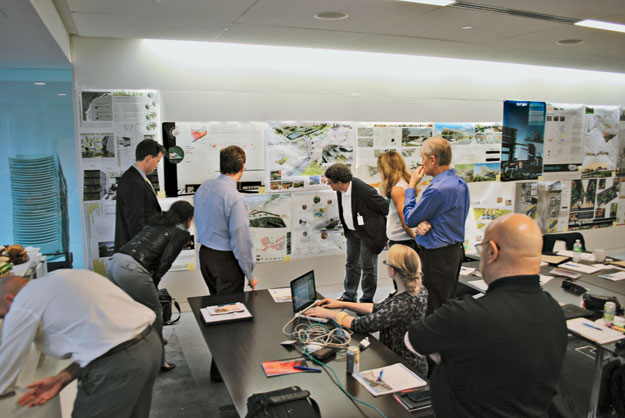Architecture firms are increasingly offering in-house design awards in an effort to boost morale and inspire creativity.
Ed Feiner, the former chief architect of the General Services Administration, made a name for himself creating the agency’s well-regarded Design Excellence program, which raised the creative bar for government buildings. Today, he’s taking on a similar challenge at Perkins+Will (P+W), which he joined in 2009. As director of the firm’s design Leadership Forum, started in collaboration with chief executive Phil Harrison and design principal Ralph Johnson, Feiner coordinates several in-house award programs that aim to recognize and encourage better design aross the company’s 23 offices, totaling 1,600 employees. “A little competition is a good thing, particularly if it’s positive,” Feiner says.
P+W is not alone in offering internal design awards. In recent years, practices of all sizes have introduced similar initiatives, including RTKL, whose “Works in Progress” program began in 2005, and HOK, whose “BIM-ies” started in 2010. Organizers say the programs not only enable employees to stay apprised of each other’s work, but also serve as important recruiting tools. Most critically, they spark creativity and boost morale. “You’re not going to win a $600 million lottery prize,” Feiner says, “but you stand a good chance of being respected by your colleagues.”
Of course, organizing these programs can be daunting, particularly for megafirms. A methodical process is key, Feiner says. For P+W's recent in-house 'biennale,' Feiner asked the six judges, all of whom work outside the firm, to initially review the 149 submissions online and pick their top 20. Later, the judges convened in New York for a fivehour session in which they selected 16 winners and 16 recommendations. The entries ranged from completed towers to on-theboard schemes.
While programs often begin as internal reviews, many now rely on external judges from the fields of academia, journalism, and real estate development. These outsiders can provide 'an interesting perspective on what's happening in the world,' says Carlos Martinez, the Gensler principal who oversees the firm's Design Excellence Awards, which began in 2000 and have ballooned in popularity. With growing interest comes challenges: Last year, Gensler's 3,500 employees, dispersed among 41 offices, contributed a hefty 190 entries, forcing Martinez to nix projects that won't be built in the foreseeable future. In the end, the six jurors'including Tom Buresh, chair of Berkeley's architecture department, and Alexa Arena, a vice president at Forest City, a Bay Area developer'evaluated 160 entries and picked 20 winners, ranging from an Atlanta office renovation to a fritted-glass facade for a Chicago college building.
Though confidentiality agreements prevent Martinez from publicly sharing certain winners, many do end up in promotional e-mails. The goal is to remind clients that the firm is multifaceted. 'We want them to think, 'I didn't know Gensler had done that,'' says Martinez.
Some firms go far beyond e-mail blasts. In 2001, Skidmore, Owings & Merrill published its first SOM Journal, a 200-page monograph that showcased five designs selected by an external jury. 'My aspirations in the beginning were more about communicating what we were doing so that young talent would come here,' says partner Roger Duffy, who compiled the inaugural journal; they have since published six more. 'It has blossomed into something nobody could have imagined.' Today, mixed with the winning projects are essays that explore a theme, like teamwork, which will be the focus of Journal 8, due this fall. It will be available for sale.
For NBBJ, the focus is more on rewarding talent internally. Its 'Projects of the Year' program, launched in 2007, has been so well received that the 700-employee firm added five categories this year, says A.J. Montero, a partner based in Columbus, Ohio, who oversees the program.
The entries are generally evaluated by two in-house designers and three visiting jurors. 'It costs money to fly people in, but when you think about the great feedback you get, it's worth it,' Montero says. The jury spends a full day studying the entries before announcing winners. This year, the grand prize went to the team behind the Lunder Building at Massachusetts General Hospital (2011), which will star in a video shown in all eight NBBJ offices. In-house programs also help firms improve their applications for external programs, such as AIA chapter awards, says Omahabased Tom Trenolone, a principal at HDR. He manages the company's 'Opacity' program, which the 185-office company introduced in 2008. 'It's a great proving ground,' he says.
Even when the jury constitutes staff members, there's still much to be gained, says David Parks, a senior associate at Gould Evans, the 150-member firm in Kansas City, Missouri, that started an awards program in 2006. Winning projects, selected largely by an in-house team, are presented in a book and on the company's internal website. It's no Mega Millions jackpot, but garnering peer recognition and elevating a firm's design standards have their own payoffs.


Post a comment to this article
Report Abusive Comment